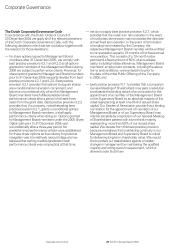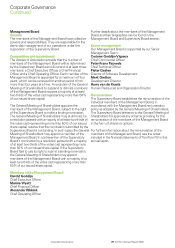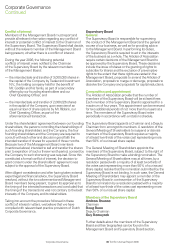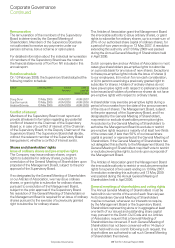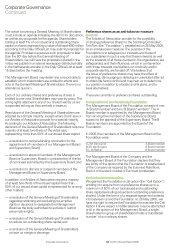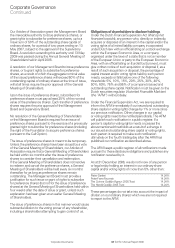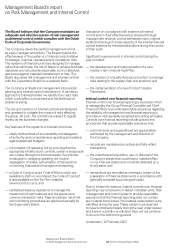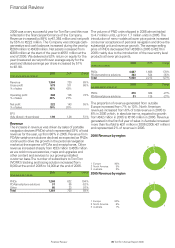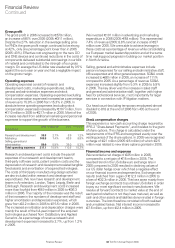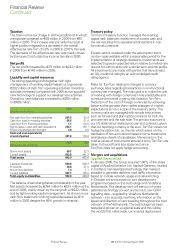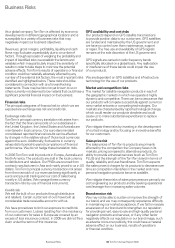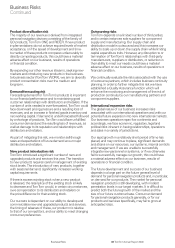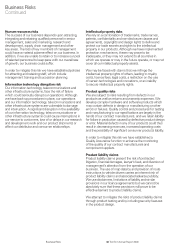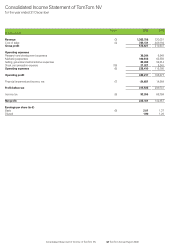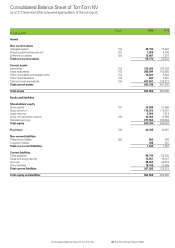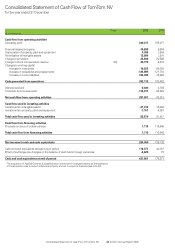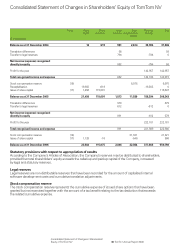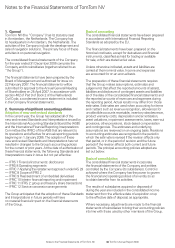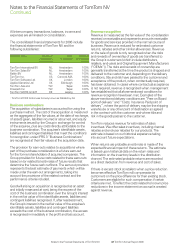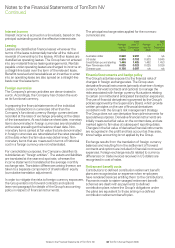TomTom 2006 Annual Report Download - page 40
Download and view the complete annual report
Please find page 40 of the 2006 TomTom annual report below. You can navigate through the pages in the report by either clicking on the pages listed below, or by using the keyword search tool below to find specific information within the annual report.38 TomTom Annual Report 2006
As a global company TomTom is affected by economic
developments in different geographical locations and is
susceptible to a variety of business risks that may
negatively impact our business objectives.
Revenues, gross margins, profitability, liquidity and cash
flows may fluctuate unpredictably due to a number of
factors. Through a process of weighing the probability and
impact of identified risks we establish the factors and
variables which may particularly impact the sensitivity of
results in order to take steps to minimise the potential
adverse effects. TomTom’s results of operations or financial
condition could be materially adversely affected by any
number of the external risk factors; the most important risks
identified are highlighted below. These risks should be
considered in connection with any forward-looking
statements. There may be risks not yet known to us or
others currently not deemed to be material that could have a
significant potential financial impact on the business.
Financial risks
The principal categories of financial risk to which we are
exposed are exchange rate risk and credit risk.
Exchange rate risk
TomTom’s principal currency translation risk arises from
the fact that the financial records of our subsidiaries in
the United Kingdom, the United States and Australia are
maintained in local currency. Our euro-denominated
consolidated reported financial results can be affected
by changes in the relative value of those local currencies
against the euro. Additionally, fluctuations in currency
values distort period-to-period comparisons of financial
performance. We do not hedge these translation risks.
In 2006 TomTom sold its products in Europe, Australia and
North America. The products are sold in the local currency
to distributors and retailers. Our PNDs are sourced from
contract manufacturers in Asia and mainly priced to us in US
dollars. TomTom’s principal currency transaction risk arises
from the mismatch of our revenues being significantly in
euros and pounds sterling and our cost of sales being
mostly in US dollars. We manage these currency
transaction risks by use of financial instruments.
Credit risk
We sell the bulk of our products through distributors
and retailers. Certain customers of ours have built up
considerable trade receivable accounts with us.
We have procedures to limit our exposure to credit risk
from our customers. Losses resulting from the insolvency
of our customers for sales in Europe are covered by an
excess of loss insurance contract. In 2006 we did not file a
claim under the terms of this insurance.
GPS availability and cost risks
Our products depend on GPS satellite transmissions
to provide position data to our customers. GPS satellites
are funded and maintained by the US government and
we have no control over their maintenance, support
or repair. The free use and availability of GPS signals
remains at the sole discretion of the US government.
GPS signals are carried on radio frequency bands
specifically allocated on a global basis. Any reallocation
or interference of these bands could impair the use
of our products.
We are dependent on GPS satellites and infrastructure
technology for the use of our products.
Market and competition risks
The market for satellite navigation products in each of
the geographic markets in which we operate is highly
dynamic and competitive. There can be no assurance that
our products will compete successfully against current or
new market entrants or competing technologies. Our
markets are characterised by rapid technological change,
which could render our products obsolete and could
cause us to make substantial expenditures to replace
our products.
We mitigate these risks by investing in the development
of our technology and by focusing on innovative benefits
for our customers.
Sales price risk
The sales prices of TomTom’s products are primarily
affected by the competition the Company faces in its
markets, pricing compared to alternative products, its
ability to provide enhanced services (such as TomTom
PLUS) and the strength of the TomTom brand in terms of
quality, reliability and user-friendliness. TomTom expects
the sales prices it charges for its products to decrease over
time as competition intensifies in the market and more
personal navigation products become available.
We mitigate these risks of sales price pressure primarily via
cost engineering our products and by seeking operational
cost leverage from increasing sales volumes.
Brand erosion risk
We may not be able to sustain or improve the strength of
our brand, and we may consequently experience difficulty
in maintaining our market acceptance. If we fail to increase
awareness of our brand and to strengthen our reputation
for providing smart, easy-to-use and high-quality personal
navigation products and services, or if any other factor
negatively affects our reputation or our brand image, such
as adverse consumer publicity, this could have a material
adverse effect on our business, results of operations
or financial condition.
Business Risks
Business Risks


